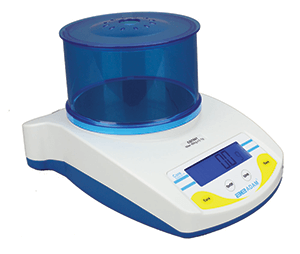
Sometimes, you just have to use your weighing equipment in the field. Whether you need to test materials on site to properly evaluate their properties or record field samples before they make it to the lab, there are times when you’ll take a weighing device outside. These tips will help you use your scale or balance on the field while keeping it protected from the elements and in good working order. Most field measurements are taken with compact scales, precision balances or bench scales, due to their portable design.
1. Pick the Right Time and Prepare
While you might not always get to choose, try to take the balance out during optimal weather conditions. Stable temperature, not too humid, avoid strong wind and harsh sunlight as well as rain, snow or hail. If you’re on a work site, try to set up your scale away from heavy machinery and vibrations, as they can affect weighing results.
Calibrate your scale before taking measurements. It’s not a bad idea to bring calibration weights in a case to check that factors such as altitude did not affect your balance onsite. It’s also not a bad idea to calibrate the scale or balance once the excursion is done if it’s going back to the lab or classroom. Check that the devices, including accessories, all work properly before setting out. Prepare recording materials. When recording results by hand, make sure to doublecheck each result, and if you write it down, write and annotate neatly to make sure it can be read and transcribed later.

2. Use the Draft Shield
If your balance features a draft shield (like some Core and Highland models), take advantage of it! Depending on the sample size, even a soft breeze could affect results. A draft shield helps protect your sample from environmental conditions and ensures your balance deliver reliable results. This is particularly important for very light and powder-based samples like insects or pollen.
3. Clean Your Stainless Steel Pan
Field samples can be messy, especially for natural sciences and material testing. Carry wipes or a sponge to wash debris and dirt off the stainless steel pan. Some balances even feature a removable sample pan for easy cleaning. This helps prevent cross contamination, keeps your equipment clean and reduces the chances of rust or other chemical and environmental damage. If you don’t clean your scale quickly, debris can accumulate and affect results. It can also be much harder to clean later on (ever left sauce on a plate for a few days? Just like that).

4. Take Advantage of Accessories
A carrying case is absolutely essential for field measurements, particularly if the site is out of the way and requires lengthy transport or the conditions are difficult. A solid case helps prevent accidental damage during transport and protects your weighing device from shocks that could require calibration to fix at best, and paid repairs at worst.
If you can, use a clear cover to protect your scale from spills, dust and other field hazards such as slimy amphibians. It will help keep it clean and working properly longer. You want to be especially careful with small openings, as dirt could get lodged in the inner mechanism and damage the balance.
Make sure you have plenty of recording materials. If your scale has a USB interface, a data logger can quickly register data sets. If not, you can connect your scale to a portable printer. If you’re using one of these devices, be sure to configure the settings before heading out. If you’re using a laptop, tablet or a notepad, make sure you have a case to protect them from weather or dirt. Bring multiple pens along in case you lose one.

5. Use Selectable Digital Filtering
Selectable digital filtering can adjust the balance’s sensitivity when it’s used in areas with vibrations or when dealing with moving samples. Use the manual to familiarize yourself with the settings and conduct tests to find which settings work best for your needs. Sensitive balances can sometimes struggle to deliver stable results in rigorous environments, so it’s important to find that fine line between quickly stabilizing the balance and detecting small but important changes in weight. This is particularly important for balances that do not have a dynamic weighing function.
6. Make Sure Your Scale Has a Rechargeable Battery or Can Run on Batteries
While some worksites will have temporary installations or charging stations, field operations often lack access to electricity, particularly in natural sciences where scientists have to go deep into a variety of natural uninhabited terrains. This means your scale or balance must be able to operate without a power cord. You don’t want to finally arrive onsite only to realize your weighing device is powerless. Many scales feature a rechargeable battery. Some compact scales allow operation with AAA batteries as well. Make sure they are fully charged prior to the excursion. If your scale has a USB interface like our Latitude compact bench scale does, you can also use a car or a charging bank to keep it powered longer.

7. Create Stable Conditions
Most balances feature a stability indicator of some kind, so take advantage of them. Compact scales like our CB and CBX have a bubble level, while a precision model shows a symbol representing stability on the display. Do not start measuring until the level is properly adjusted or the stability indicator stays consistently on the display. Some weighing devices feature adjustable feet that can accommodate uneven surfaces. Be sure to check stability often and adjust as needed.
8. Some Useful Features
While functionalities often depend on your needs, there are a few features that work well for most field conditions.
ShockProtect: as the name indicates, a scale or balance with ShockProtect is protected again accidental shocks and damages resulting from falls or overloads. This is particularly useful in rough terrain or during class excursions with inexperienced students. As you can see in this case study, our Core balance was able to function even after being knocked off a table. Try to treat your balance with care and caution, even if it has that feature.
HandiCal: You might not have the time or conditions to properly calibrate your balance outside. HandiCal and automatic internal calibration options enable your balance to account for changes in temperature or ambient conditions for reliable results anywhere.

Animal / Dynamic Weighing: if you’re in life sciences and often need to measure live samples, this feature is essential. The scale works out an average weight based on the force exerted by the animal over an extended period of time. Once the internal calculation is completed by the balance, it holds the value. Most scales with a dynamic weighing option also include various levels of digital filtering, so users can choose options that fit their samples best. That can be useful on ships to measure fish, for example, since the scale must take live fish and the rocking of the vessel into account.
Checkweighing and counting features can be useful for creating batches of samples that will be used for further analysis or for quick subject evaluation. Users can set audible alarms or view the display to see if a sample is over, under or within a preset weight.
Overload protection helps protect the balance’s inner components when the balance is accidentally overloaded. It’s particularly useful for students, who may not pay attention to the device’s capacity.

Most importantly, be prepared. Before setting out on a trip with your scale, test it in your lab or outside to see what effects moving samples or testing sites it will have on it. And then make sure you have everything you need for when you are on the job site. Creating a list of items to bring will make sure that you don’t turn up unprepared.
If you need to weigh samples on the field, but you’re not sure what scale or balance to get, why not contact us? We’ll be happy to help you find the right balance. Already using an Adam product on the field? We’d love to feature you in one of our case studies.

